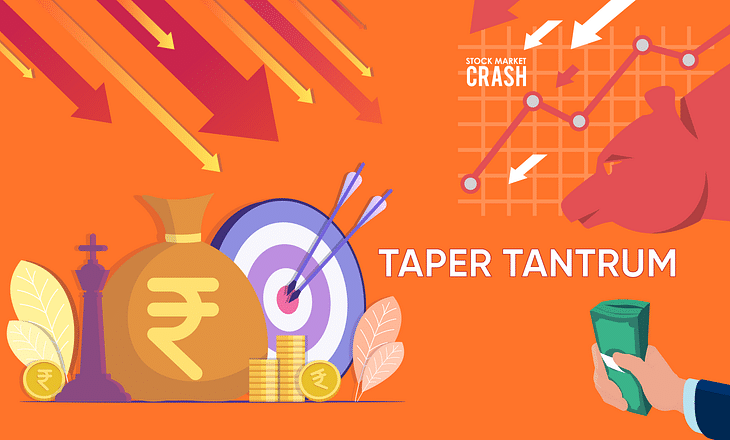What Is Taper Tantrum? Can It Affect The Indian Economy?

Ex-RBI Governor Raghuram Rajan in a statement said that India could face another ‘Taper Tantrum’ sometime soon. A Standard and Poor’s(S&P) report stated that India, Philippines most vulnerable in a ‘taper tantrum’-like scenario. So what exactly does the word ‘taper tantrum’ mean? What does it mean for the Indian economy? Let’s find out.
The Taper Tantrum of 2013
- The story dates back to the 2008 housing market crisis in the US. Banks had given out huge amounts in housing loans to people who couldn’t afford to pay it back. At the end of it, banks were left with huge amounts in unpaid loans, the stock markets had crashed. Eventually, a lot of money was lost in bad loans, crashed stock markets, and junk bonds. The global economy was crippled.
- This is when the US Federal Reserve or the Fed, which is the central bank in the US comes into the picture. The US Fed announced Quantitative Easing(QE). In Quantitative Easing, the government is essentially pumping money into the economy. It does so by cutting interest rates, buying bonds from the market, policymaking, and other banking instruments. The Fed had the mission of refilling the banks and the economy with cash.
- Remember, in bonds, as the demand for them increases, their price increases, and yield decreases, and vice versa. The Fed first bought all the short term US-Treasury notes from financial institutions, this decreased the short-term interest rates. However, the interest rate on long-term notes was intact. Soon, short-term interest rates on loans were almost close to zero. This is good for the borrower, but what about the lender? It’s bad news for the lender. The lender then has to search for other instruments yielding higher interest rates. Finally, The investors in the US found two solutions, the stock market and foreign investment in developing countries.
- India wasn’t impacted much by the global economic crisis in 2008. Fairly so, India became an investment opportunity for US Investors. While the global flows had declined by 10.5% in 2008, Foreign Direct Investment(FDI) in India increased by 46% the same year. This was the case with many developing economies. They received foreign investment in huge amounts from already developed countries that were affected by the global economic crisis. These developing countries prospered from foreign investments.
- Now comes the ‘Taper Tantrum’. Fast forward to 2013, the economy had revived, things were going pretty well all around the world, which is when the Fed announced that they were going to ‘taper’ or ‘wind down’ the Quantitative Easing(QE) or essentially stop pumping money into the system. While this was just an ‘announcement’ this sent ripples across the globe.
- Now, foreign investment is much riskier than investing in local sovereign bonds. The announcement by the Fed to taper the Quantitative Easing made investors believe that the interest rates back home would go up. This would increase the incentive to invest in safer domestic instruments like bonds over foreign investment.
What was the Impact?
- What was the impact of the announcement? Naturally, since the stock markets were overpriced, investors started withdrawing money from the stock markets. They also started withdrawing funds that were invested in the emerging markets. This caused economic turmoil in emerging markets across the world. Investors started exchanging the local currency (Indian Rupee) for the Dollar. This had a negative impact on the price of the Indian Rupee(INR) against the US Dollar(USD).
- Since the government would stop buying bonds from the market, it was perceived that bond prices would decrease. Therefore, the bondholders started selling their bonds which lead to a decrease in price and increase in yield of bonds. This period was relatively short-lived and therefore called the ‘Taper Tantrum’. Even though the Fed had announced, it decided to hold back on its decision after the Taper Tantrum for some time.
Taper Tantrum Coming Back?
The economic situation in 2021 is similar to that of the economic crisis in 2008. When the taper tantrum occurred, sectors with high foreign investments, debt mutual fund holders, and bondholders were affected the most. Governments are intensively pushing stimulus packages and Quantitative easing programs to restart the economy. Stock markets are overpriced and a lot of foreign investors have shored up in emerging markets.
Finance Minister Nirmala Sitharaman said that India does not face a risk of Taper Tantrum, as it did in 2013 and that the ministry and RBI are vigilant enough to avoid the situation this time.
The last Taper Tantrum was a panic reaction from investors in a volatile market. It wasn’t correlated to any other macroeconomic factors in the past. The macroeconomic conditions of 2021 aren’t similar to that of 2013. Unlike last time, economists and bankers might have learned their lessons and a Taper Tantrum-like situation might not actually happen after all.


Post your comment
No comments to display